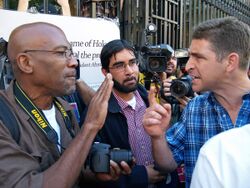Philosophy:Argumentative dialogue
This article needs additional citations for verification. (November 2019) (Learn how and when to remove this template message) |
Whereas formal arguments are static, such as one might find in a textbook or research article, argumentative dialogue is dynamic. It serves as a published record of justification for an assertion. Arguments can also be interactive, in which the proposer and the interlocutor have a more symmetrical relationship. The premises are discussed, as well the validity of the intermediate inferences. For example, consider the following exchange, illustrated by the No true Scotsman fallacy:
- Argument: "No Scotsman puts sugar on his porridge."
- Reply: "But my friend Angus likes sugar with his porridge."
- Rebuttal: "Ah yes, but no true Scotsman puts sugar on his porridge."
In this dialogue, the proposer first offers a premise, the premise is challenged by the interlocutor, and finally the proposer offers a modification of the premise. This exchange could be part of a larger discussion, for example a murder trial, in which the defendant is a Scotsman, and it had been established earlier that the murderer was eating sugared porridge when he or she committed the murder.
In argumentative dialogue, the rules of interaction may be negotiated by the parties to the dialogue, although in many cases the rules are already determined by social mores. In the most symmetrical case, argumentative dialogue can be regarded as a process of discovery more than one of justification of a conclusion. Ideally, the goal of argumentative dialogue is for participants to arrive jointly at a conclusion by mutually accepted inferences. In some cases however, the validity of the conclusion is secondary. For example; emotional outlet, scoring points with an audience, wearing down an opponent or lowering the sale price of an item may instead be the actual goals of the dialogue. Walton distinguishes several types of argumentative dialogue which illustrate these various goals:
- Personal quarrel
- Forensic debate
- Persuasion dialogue
- Bargaining dialogue
- Action seeking dialogue
- Educational dialogue
Van Eemeren and Grootendorst identify various stages of argumentative dialogue. These stages can be regarded as an argument protocol. In a somewhat loose interpretation, the stages are as follows:
- Confrontation: Presentation of the problem, such as a debate question or a political disagreement
- Opening: Agreement on rules, such as for example, how evidence is to be presented, which sources of facts are to be used, how to handle divergent interpretations, determination of closing conditions.
- Argumentation: Application of logical principles according to the agreed-upon rules
- Closing: This occurs when the termination conditions are met. Among these could be for example, a time limitation or the determination of an arbiter.
Van Eemeren and Grootendorst provide a detailed list of rules that must be applied at each stage of the protocol. Moreover, in the account of argumentation given by these authors, there are specified roles of protagonist and antagonist in the protocol which are determined by the conditions which set up the need for argument.
Many cases of argument are highly unsymmetrical, although in some sense they are dialogues. A particularly important case of this is political argument.
Much of the recent work on argument theory has considered argumentation as an integral part of language and perhaps the most important function of language (Grice, Searle, Austin, Popper). This tendency has moved argumentation theory away from the realm of pure formal logic.
One of the original contributors to this trend is the philosopher Chaim Perelman, who together with Lucie Olbrechts-Tyteca introduced the French term La nouvelle rhetorique in 1958 to describe an approach to argument which is not reduced to application of formal rules of inference. Perelman's view of argumentation is much closer to a juridical one, in which rules for presenting evidence and rebuttals play an important role. Though this would apparently invalidate semantic concepts of truth, this approach seems useful in situations in which the possibility of reasoning within some commonly accepted model does not exist or this possibility has broken down because of ideological conflict. Retaining the notion enunciated in the introduction to this article that logic usually refers to the structure of argument, we can regard the logic of rhetoric as a set of protocols for argumentation.
This article does not cite any external source. HandWiki requires at least one external source. See citing external sources. (2021) (Learn how and when to remove this template message) |


